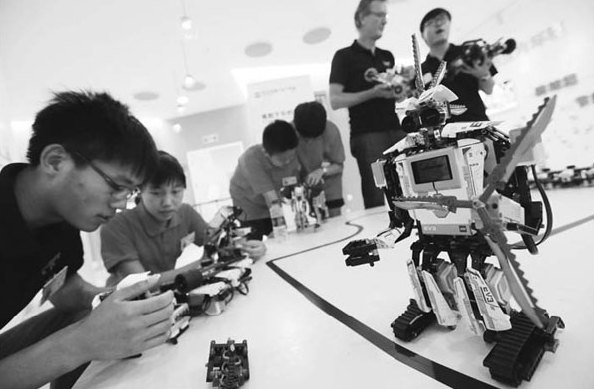Robot classes set students up for future careers
Updated: 2013-08-15 08:01
By Liu Zhihua (China Daily)
|
||||||||
|
Students show interest in the robot series, EV3, produced by Lego, the largest educational robot provider in China at the toy's launching ceremony. Provided to China Daily |
Zhang Hang, 12, stares at a robot that moves around cleverly on the stage.
Shaped like a truck, the robot stands about 20 centimeters high, and moves at the command of an operator, who gives orders using a wireless controller attached to his hand.
"Robots are so cool," Zhang says at the launching ceremony of a new toy giant under Lego's educational robot series, EV3.
"I cannot wait to start my middle school, because my middle school will have robot classes."
When school reopens in September, Zhang will be enrolled in Beijing No 12 Middle School, which is famous for its robot courses.
Just like Zhang's school, many primary and middle schools in China have been providing robot education to students in recent years.
Although there are no reliable national statistics, according to Lego, the largest educational robot provider in China, there are now more than 20,000 schools in most of the provinces using their robots to offer classes to students. There are also 69 after-school educational robot centers in 24 cities that have 10,000 family memberships.
Besides, there are also various other domestic and foreign educational robots, such as Grandar Robotics, and Fishtech.
"I don't know how many primary and middle schools provide robot education nowadays, but I'm sure the number has been increasing very quickly in the past years," observes Wang Jihua, a senior robot teacher in Shanghai Shixi School, which started the first robot class for schools in Shanghai in 1999.
The increase has become accelerated since 2003, when the national educational authority included artificial intelligence introduction and basic robot designing knowledge as part of standard optional courses for middle schools, Wang adds.
There may be different brands and prices, and the items differ for various age groups, but a standard set usually contains intelligent bricks or blocks with computerized sensors, remote controller and an explanation booklet.
In a robot class, teachers cover topics such as what robots are and how they work, and divide students into groups to design and assemble robots.
Zheng Jianchun, a robot class teacher of Beijing No 12 Middle School, says when he started teaching robot-related knowledge in late 1990s, there were few students who showed interest, but now students are very passionate about robot classes.
In his school, there are required robot courses for senior students, and optional courses and clubs for junior students. The classes always get an overwhelming response.
Students benefit a lot from those classes, says Zheng, who in 2010 authored a best-selling book titled Structure and Program of a Robot based on his teaching experiences.
"By designing and controlling a robot, students can better understand knowledge acquired in courses such as physics and mathematics, and then learn to apply the knowledge in real life," Zheng says.
Ethan Danahy, an engineering education specialist from Tufts University, Boston, Massachusetts, the United States, agrees with Zheng.
He thinks the current problem in education is the lack of motivation among students, and the robot is a great product to help change that.
"When students work with their hands, they are engaged, and are inventing, creating and building new solutions to problems," Danahy says.
Many of Zheng's students are admitted into top-level universities, such as Harvard, Peking and Tsinghua, majoring in engineering and computer science, among others.
But Wang Jihua, the robot teacher with the prestigious school in Shanghai, says that is not the reason to use robots. Robot classes make students more creative and cooperative, and inspire their interest and sense for science, rather than to help students score better in examinations, Wang says.
"I think the most beneficial thing a robot class can give to students is to make them realize whether they love science or not," Wang says.
Wang himself has led his students to participate in several robot-designing competitions, but he says not all schools are able to have students exposed to such activities, because of financial constraints.
A set of educational robots, usually used by a group of four to six students, costs thousands of yuan, and only well-to-do schools can afford it. Wang's school has spent 210,000 yuan ($34,000) on its robot classes this year.
liuzhihua@chinadaily.com.cn
(China Daily USA 08/15/2013 page10)

 Spielberg has desire to work with Zhang Yimou
Spielberg has desire to work with Zhang Yimou
 Requiem ceremony for former comfort woman
Requiem ceremony for former comfort woman
 Egypt forces crush protesters
Egypt forces crush protesters
 Two killed in fiery crash of UPS cargo jet
Two killed in fiery crash of UPS cargo jet
 Yao dreams of sports for fun with towering charity
Yao dreams of sports for fun with towering charity
 Re-enacting ancestors' journey to the west
Re-enacting ancestors' journey to the west
 Special bus seat for breast-feeding mothers
Special bus seat for breast-feeding mothers
 Northern exposure
Northern exposure
Most Viewed
Editor's Picks

|

|

|

|

|

|
Today's Top News
US asks China's help on DPRK issues
Movie tax flack is settled
Manning 'sorry' for US secrets breach
China to be world's No 1 consumer
Gold rises on physical buying from Asia
Millionaires hold dimmer view: Survey
China to probe foreign automakers
Snowden case not to affect US-Russia talks
US Weekly

|

|






